Annapurna Base Camp Trek – 12 Days
TripAdvisor Reviews Recommended by 99.99% travelers
USD 800
Nepal
12 Days
Moderate
ABC (4,130 m/13,549 ft)
Hotel/Lodge/Teahouse
Tourist bus/Domestic Flight
Min. 2 pax - Mix. 25 pax
Spring (Mar-may) & Autumn (Sep-Nov)
- This Trek will provide you with breathtaking views of the Annapurna Himalayan range, including majestic peaks like Annapurna I, Annapurna South, and Machapuchare (Fishtail)
- Expansive views of snow-capped mountains, verdant valleys, rolling hills and striking sceneries
- Opportunities to encounter diverse wildlife, such as Himalayan Thar, musk deer, langur monkeys, and various species of birds, while walking in the Annapurna Conservation Area
- Interact with local people living in the Annapurna Region, which is mainly inhabited by Gurung and Magar communities. Discover their lifestyle, unique traditions, culture, and warm welcome during your trip.
- Chance to enjoy various kinds of delicious Nepali dishes. From the classic rice, curry, and lentil dish Dal Bhat to the dumplings Mo: Mo, traditional noodle soup Thukpa and plenty of mouth-watering dishes.
- Trek with a local guide and porter who will make your journey more exciting with their interesting stories. They provide unwavering assistance, ensuring that your trip will be more enjoyable at every step.
- See a mountain dog (known as a “Bhote Dog” in Nepali), the mountaineer guard, and welcoming photo possibilities.
- Immerse yourself in the Jingu, which is natural hot spring water. It is believed that taking a bath in this natural water will cure skin disease.
- Enjoy the scenic road trip, or opt for a plane and be amazed by an unbelievable aerial perspective.
Annapurna Base Camp Trek – 12 Days Brief Insight
Have you ever dreamed of walking to the base camp of the uniquely shaped Mt. Machhapuchhre (6,993 m), also known as Fishtail, and the world’s tenth-highest mountain, Annapurna( 8,091 m)? This 12-day Annapurna Base Camp Trek provides you with the opportunity to visit and explore both ABC and MBC in a single trip.
Annapurna Base Camp Trek is a perfect mix of adventure and comfort, offering you the chance to experience the majestic beauty of the Annapurna Sanctuary. For this reason, ABC Trek is also known as the Annapurna Sanctuary Trek.
Your journey on the ABC trek begins primarily from Pokhara, which is easily accessible by either a 30-minute flight or a 6-hour drive from Kathmandu. Before you start your trekking journey, this trip allows you to immerse yourself in the natural beauty of Pokhara. Also known as the gateway to the Himalayas, it is home to many notable mountains, including Annapurna I, II, III, Hiunchuli, Gangapurna, Machhapuchhare, Mardi Himal, and Tilicho Peak.
The peaceful environment and calming natural surroundings, like Phewa Lake, add to the beauty of your trip. Pokhara is full of adventure, history, and culture, and offers numerous attractions for visitors.
From Pokhara, you will take a private vehicle and take a scenic ride to Ghandruk. Ghandruk is one of the famous villages in Pokhara. This village is also known as Gurung village, as the Gurung people mainly dominate it. From this village, you can get the majestic view of Mt Annapurna, Mt Machapuchare, Gangapurna, and Mt Hiunchuli.
You will get the opportunity to meet the various other trekkers in this village who are heading for the Annapurna Base Camp, Annapurna Circuit treks, and Poonhill. The warm hospitality from the Gurung people and chances to taste the local food while staying in the local village will make your trip more memorable.
Mostly, you will pass through the well-marked route during the ABC trek. The ABC trekking route consists of greenery, lush hills, a Rhododendron forest, a Bamboo forest, a cascade, a waterfall, and a small wooden bridge. You will walk up the stone-paved stairs, which are 3,000 steps to reach Ulleri, and this path is known as the challenging section of this trek. The higher you reach, the scenery will change, and a wider view of the mountain range is seen.
During the trek, you will stay in the tea house, which will provide you with the basic facilities of food and accommodation, including amenities like electricity, wifi, toilets, and a hot shower. This tea house promises to provide you with comfortable shelter during your visit to the base camp of Annapurna.
Trekking in the remote region of the Annapurna with your trekking Guide and the porter while listening to their stories and getting insight into the area is truly enjoyable. You’ll also have the opportunity to interact with the local people, gaining a deeper understanding of their culture, traditions, and rituals.
The main highlight of the Annapurna Base Camp trek is walking the trails of the Annapurna Sanctuary and exploring its natural beauty. Also, spending the night after a long hour of trekking in a tea house, which is surrounded by a towering mountain range, is beyond imagination.
This trek is the most popular in the Annapurna Region and is suitable for both novice and experienced trekkers. Anyone who walks this trail will be amazed by the natural beauty of the Annapurna Region.
Are you ready to join this trip with Eco Nepal Trekkers? You can book this trip by filling out the inquiry form or simply by emailing us at [email protected] or calling us at +977-9813322433 (WhatsApp, Viber, IMO).
Major Attractions of the Annapurna Base Camp Trek
Panoramic Views of Annapurna and Dhaulagiri Ranges
On this 12-day trek, you will witness the breathtaking view of the 10th-highest mountain in the world, Annapurna, a striking view of Machapuchare (Fishtail Mountain), Hiunchuli, Dhaulagiri, and the Annapurna Range.
Witnessing this majestic snow-capped peak, which stands high above the clouds, will be your constant companion. Its breathtaking view will leave such an impression that it will remain long after your trek is over.
At the heart of the trek lies the Annapurna Sanctuary, a natural amphitheatre surrounded by stunning peaks. This serene area, considered sacred by locals, offers a peaceful and enriching experience amidst one of the most picturesque settings in the Himalayas.
Annapurna Sanctuary
During the Annapurna Base Camp trek for 12 days, you will get the chance to step into the Annapurna Sanctuary, which is a high glacial basin lying 40 km directly north of Pokhara. The Annapurna range of mountains, the majority of which are over 7000 meters high, encircles this paradise.
Also, other scenery, such as Rhododendron forests that bloom in the spring, Junipers, oaks, and pine trees, Lowland villages, Subtropical forests, Paddy fields, Icy rivers, and Glaciers, are equally stunning.
Diverse Landscapes
Another feature of trekking to the Annapurna Base Camp is that you will enjoy walking in the diverse landscape. You will pass through the lush tropical forest and the terrace field in the lower region. The higher you reach, the path will change into the alpine meadow and rocky trails. Changing the scenery during every step of this trek will add joy and excitement to the trekkers.
Unique Flora and Fauna
Annapurna lies inside the Annapurna Conservation Area, which is home to a diverse range of plants and animals. You can also witness endangered species of animals such as the Snow Leopard, the Himalayan Tahr, the Red Panda, and the Musk Deer.
Also, watching the different species of birds and hearing their melodious sound, like a song, makes your journey more enjoyable and entertaining. Also, make sure to carry the binoculars to enhance your wildlife viewing experience.
Cultural Experiences in Gurung and Magar Villages
During this trek, you will pass through the traditional, charming villages that the Gurung and the Magar communities mainly inhabit. Their unique cultural dress, lifestyle, way of living, and most importantly, warm hospitality will make you feel like you’ve always been a part of their community. Nepal’s unique culture, rich traditions, and friendly people are so special that it drags you to keep coming back again and again.
Hot Springs at Jhinu Danda
After spending some weeks in the Annapurna region and completing the ABC Trek, you will get the opportunity to relax in the natural hot spring, Jhinu Danda.
This natural hot spring will treat your tired legs and muscles, and taking a bath here is believed to it will remove your skin-related problems. It’s like giving natural therapy to your body.

Spectacular Sunrises and Sunsets
Do you love seeing the sunset and sunrise? These kinds of events are something different in mountainous areas. When the sun rises and sets, it turns the towering peak into different colors, and the dramatic view of such a natural phenomenon will leave you in awe. Such a magnificent vista that you won’t see every day, and it’s unforgettable.

Thrilling Trails and Suspension Bridges
Most people have seen cement bridges, but have you ever walked across a hanging suspension bridge made of sturdy steel cables? The rushing river flowing underneath and walking on this thrilling bridge during the trek is something that you will not find in many places. It’s like enjoying the village lifestyle with pure fun and adventure.
Peaceful Bamboo and Rhododendron Forests
Another major attraction of the Annapurna Base Camp trek is walking in the peaceful bamboo and Rhododendron forest. Walking through this peaceful forest allows you to connect to nature and understand its real beauty.
High-altitude flower Rhododendron, which blossoms in many colors (red, pink, purple, and white) in the spring season, makes the trail colorful and creates a magical atmosphere. Walking on such a trail will surely make your heart happy.
Annapurna Base Camp 12 Days- Is this the Right Trip for you?
The ABC trek, 12 days, is a moderately challenging trek. There is no technical section involved in the trek. Therefore, you can join this trek even if you don’t have previous trekking experience. But you should be physically fit and prepared for this trek.
This trek trail includes steep stairs, such as the famous 3,000-step climb to Ulleri. Climbing the steep stone stairs with ascending and descending might be demanding and painful on the knees if you are not used to trekking for lengthy hours.
Also, the maximum height you’ll reach is 4,130 meters at the Annapurna Base Camp. Therefore, walking at such an altitude for some trekkers might be difficult due to the altitude effect. So, proper acclimatization is required to avoid altitude sickness and other health-related issues during the trek.
Another important point to understand is that weather conditions can change suddenly in high-altitude mountain regions. Weather changes can cause temperature fluctuations, and at times, bad weather may disrupt your plans. Therefore, you should include extra days in your itinerary as a backup for any delays.
What to Expect on the 12 Days Annapurna Base Camp Trek?
Your 12-day Annapurna Base Camp guided trek starts from the capital city of Nepal, Kathmandu. Then, you will take either road transportation/flight to reach Pokhara, which is the gateway of the Annapurna Base Camp Trek. Then, you will drive from Pokhara to Ghandruk in a private jeep.
Then, you will start your first trek from the Traditional village of Ghandruk towards the Annapurna. You will walk in a group with a team of Eco Nepal Trekkers. Each day, after having breakfast in the communal dining in the tea house, you will prepare for your everyday destination as per the itinerary we will provide you.
You will be walking around 5-6 hours daily, and your trekking guide will choose the destination in the middle of the journey for lunch. At the end of the everyday journey, you will spend the night in the cozy tea house, which is pre-booked by the Eco Nepal Trekkers for you.
Annapurna Base Camp Trek Cost For 2025/2026
The Annapurna Base Camp Trek Cost directly depends upon the number of days you want to spend in the mountain, the traveling season, the type of mode of transportation you prefer, and the comfort facilities like lodging and food. If you book this trek with Eco Nepal Trekkers, it will cost you 800$ per person.
We, Eco Nepal Trekkers, provide a special discount if you are in a large group.
Let’s see the Cost according to the group-wise:
| NO OF PERSONS | COST IN USD |
| Solo (1 pax) | $1050 |
| 2 pax | $800 |
| 3-5 pax | $750 |
| 6-8 pax | $700 |
| Above 12 | $500 |
Annapurna Base Camp Trek Booking For 2025
If you are willing to undertake this amazing trek in 2025, full of adventure, here are the steps to book/reserve your spot for trekking in 2025;
- Step 1: Read the Trek Package carefully, paying attention to details such as itinerary days, cost, and what is included and excluded in the trekking package.
- Step 2: You can easily download the package from our website, and also send it to us.
- Step 3: After that, Eco Nepal Trekkers will contact you. We will explain further about the package and want to ensure that it will meet your interests and desires.
- Step 4: Next, you have to send us 25% of the total package cost to book your spot for the ABC trek. Once you receive the amount, we will notify you via email.
Note: We also accept last-minute bookings.
Advance Booking Annapurna Base Camp Trek for 2026
Although booking the Annapurna Base Camp Trek too early may seem like a disadvantage, there are several benefits to doing so. One of the main benefits is that you won’t have to worry about price increases in 2026, as your seat will be reserved at the 2025 package price.
Early booking also guarantees that all your arrangements are verified well in advance and that your departure is confirmed. It will help to keep you dedicated to the journey by avoiding gradual changes in mood or second thoughts.
Beyond that, you will have sufficient time to prepare for the trek and manage your budget, which helps make your journey seamless and hassle-free. Booking your trek for 2026 is like making your journey fully stress-free, adventurous, and full of unforgettable memories.
- Day 01: Arrival in Kathmandu (1,350 m/4,429 ft)
- Day 02: Drive from Kathmandu to Pokhara (827 m/2,713 ft), 6-7 hrs
- Day 03: Drive from Pokhara to Ghandruk then Trek to Chomrong (2,170 m/7,119 ft), 6 hrs
- Day 04: Trek from Chomrong to Bamboo (2,310 m/7,578 ft), 5 hrs
- Day 05: Trek from Bamboo to Deurali (3,230 m/10,597 ft), 5 hrs
- Day 06: Trek from Deurali to Annapurna Base Camp (4,130 m/13,549 ft), 6 hrs
- Day 07: Trek from Annapurna Base Camp to Bamboo (2,310 m/7,578 ft), 8 hr
- Day 08: Trek from Bamboo to Jhinu Danda (1,760 m/5,774 ft), 6 hrs
- Day 09: Trek from Jhinu Danda to Nayapul (2:30 hrs) then Drive to Pokhara (827 m/2,713 ft), 2 hrs
- Day 10: Drive back to Kathmandu (1,350 m/4,429 ft), 6-7 hrs
- Day 11: Sightseeing in Kathmandu
- Day 12: Final Departure
Detailed Itinerary
Day 01: Arrival in Kathmandu (1,350 m/4,429 ft)
Highest Altitude :
Kathmandu (1,350 m/4,429 ft)
Meals :
Breakfast
Today, you will land at Kathmandu International Airport (TIA), where you will proceed to Immigration to finish the visa application.
Following that, you will meet the Eco Nepal Trekkers representative. After that, we will welcome you by putting on the Khata, a ceremonial scarf that is worn in Nepal to welcome visitors and signify respect and goodwill.
Then, you will take a journey in the private car we have reserved for you in the airport parking area.
After that, riding comfortably on the Nepal highway, you’ll start to see the lively streets of Kathmandu. You will also get a view of Pashupatinath Nath Temple, which is listed as a UNESCO heritage site of Nepal, during the drive.
Approximately 20 minutes of riding, you’ll arrive in the heart of the Thamel area. Then, you will check into the comfy Hotel that we have pre-booked for you.
Later in the evening, you can step out of your Hotel and wander the streets of Thamel to explore, and you can do last-minute shopping for the Annapurna trek, like buying and renting gear and equipment.
Day 02: Drive from Kathmandu to Pokhara (827 m/2,713 ft), 6-7 hrs
Trek Distance :
201.2 km
Highest Altitude :
Pokhara (827m/2,713 ft)
Trek Duration :
6-7hrs
Meals :
Breakfast
Today, you will be heading to Pokhara early in the morning. You will have two options: either taking a flight to Pokhara or taking a private vehicle.
Option 1: Take a private vehicle( Tourist Bus/ Jeep)
Our private vehicle will be there to pick you up. Since we will depart early in the morning, make sure to prepare for the ride by having all your belongings and luggage packed and ready.
Departure Time: Start your day early, around 6:30 am, to avoid traffic in Kathmandu and maximize time in Pokhara.
Road distance: Around 200km
Road condition: Paved and off-road, expansion work
Duration: 6-7 hours by road
Scenic Highlights: Ride through Prithivi Highway along the bank of the Trishuli River, scenic views of lush hills, terrace fields, charming villages, etc.
Option 2: By Air
Departure Time: While booking the Kathmandu to Pokhara flight, make sure to book early in the morning so that you can have enough time to explore after you reach Pokhara.
Early in the morning, normally, the weather remains perfect to enjoy the best aerial view from the domestic plane from your window seat.
Flight Duration: 30 minutes
Flight Views: On a clear day, you can get the panoramic view of panoramic views of the Annapurna and Manaslu mountain ranges as well as glimpses of verdant valleys.
Note: If you choose the domestic flight from Kathmandu to Pokhara, Eco Nepal Trekkers will arrange the transportation for you to reach the airport.
You need to pay for the domestic flight as it will not be included in the package. If you need any help with booking, then we are here to help you.
Highlights of Pokhara
If you have time after arriving, consider visiting these must-see attractions:
Phewa Lake:
- Take a private or group boat to enjoy the calm water of Phewa Lake.
- Visit the Tal Barahi Temple, also known as ‘Lake Temple’, which is located between the lake.
World Peace Pagoda (Shanti Stupa):
- Take a short drive to the World Peace Pagoda temple, which is situated at the top of the hill. From here, you can see the panoramic view of Pokhara City, Phewa Lake, and, on clear days a stunning view of the Annapurna Range.
Devi’s Falls and Gupteshwor Cave:
- Explore the Unique Beauty of the famous Devi’s Fall that disappears into an underground cavern.
- Opposite Davis Falls, you can visit Gupteshwor Mahadev Cave, which holds religious importance.

Day 03: Drive from Pokhara to Ghandruk then Trek to Chomrong (2,170 m/7,119 ft), 6 hrs
Trek Distance :
9.8 km
Highest Altitude :
Chhomrong (2170m/7,119 ft)
Trek Duration :
6-7 hrs
Meals :
Breakfast /Lunch /Dinner
After enjoying a fantastic time in the popular tourist destination of Pokhara, it’s time to go to Ghandruk, the starting site for the 12-day ABC trek.
You will go to Ghandruk in a private jeep from Pokhara. It takes roughly 1 hour and 35 minutes to drive from Pokhara to Ghandruk, which is about 25.4 kilometres away.
The road to Ghandruk is mostly paved, but in some sections it is gravel. During the ride, you pass through terraced farmlands, dense forests, and rural villages.
Once you arrive in Ghandruk, which is situated at an altitude of 2,012 m, you can see the traditional Gurung settlement.
Houses here are slate-roofed, made with locally sourced stones, mud, and wood.
Talking about the trekking routes, the trails are mostly paved with stones.
Ghandruk serves as a gateway to the Annapurna region, and from here, you can witness breathtaking views of Annapurna South, Hiunchuli, and the iconic Machhapuchhre (Fishtail) peaks.
Also, you can visit the Gurung Museum for a glimpse of local culture and traditions.
We will have a delicious lunch in Ghandruk before starting to trek to Chomrong village. Today, we will start our first trek from the beautiful Ghandruk village.
Our first-day trek will be short and easy, as it takes only 3 hours to reach Chomrong village. Passing through dense rhododendron forests( During spring, you can see colourful rhododendron forests) and the suspension bridges, you will arrive at Chomrong.
Chomrong is situated at an altitude of around 2,170 meters (7,120 ft). You will arrive in the Chomrong village by late afternoon and then check into the tea house.

Day 04: Trek from Chomrong to Bamboo (2,310 m/7,578 ft), 5 hrs
Trek Distance :
6.5 km
Highest Altitude :
Bamboo (2310m/7,578 ft)
Trek Duration :
5-6 hrs
Meals :
Breakfast /Lunch /Dinner
After breakfast at the tea house today, you will depart from Chomrong village. From Chomrong, the trail starts with a steep fall down stone steps that lead to the riverbed.
You will begin your ascent uphill towards Sinuwa after crossing a suspension bridge across the Chomrong Khola, the river that runs through the valley. It’s an easy climb that leads to a ridge with breathtaking views.
After walking for around 1.5–2 hours, you will reach Upper Sinuwa (2,360 m). There are very few settlements and tea houses in this area. You can take a break, rehydrate, and refuel with some snacks while enjoying the breathtaking views of the surrounding nature.
You will now travel through thick woods from here. Bamboo and rhododendron forests fill this lush forest, which can make you feel more natural while providing shade while trekking.
Then, the track gradually lowers until changing into a broad, twisting route through the forest. While passing this area, don’t forget to spot wildlife, including colourful birds, mountain goats, and langur monkeys.
After that, you will reach Bamboo, which is 2,310 meters (7,578 feet) above sea level. Following that, you will check into a tea house, which is a basic but cosy place to stay the night. You can refuel later in the evening with a steaming bowl of noodle soup or some authentic Nepali dal bhat.

Day 05: Trek from Bamboo to Deurali (3,230 m/10,597 ft), 5 hrs
Trek Distance :
10 km
Highest Altitude :
Deurali (3230m/10,597 ft)
Trek Duration :
5-6 hrs
Meals :
Breakfast /Lunch /Dinner
On day 5 of the trek, you will pack up and start the journey to Deurali after enjoying a hearty breakfast at your teahouse in Bamboo. We will be gradually climbing higher into the Annapurna sanctuary.
At first, the trail passes through a peaceful bamboo forest before progressively inclining higher.
The journey begins peacefully and gently, thanks to the thick greenery. After about an hour, you’ll reach Dovan, a little settlement where many hikers stop for a quick rest.
Dovan is located at an elevation of 2,500 m. While taking a rest here, you can enjoy the soundscape of rushing rivers and chirping birds surrounding you. Now, leaving Dovan, you will pass through lush alpine forests interspersed with cascading waterfalls.
Even though the trail gets steeper and more rugged as you go along, the peaceful surroundings and refreshing forest air make the journey enjoyable. You’ll arrive in Himalaya, another community with basic facilities where you can stop for lunch or a short snack, around halfway through.
The peaks of Hiunchuli and Annapurna South are getting closer to the Machhapuchhre Base Camp (MBC) area as you continue your walk.
There are some harder ascents and narrower portions of the trail in the last stretch from the Himalayas to Deurali. As the woodlands eventually disappear, more open spaces with jagged cliffs, rocks, and rocky ground take their place.
The Modhi River Gorge, which the trail follows here, provides a breathtaking background for this region of the trip.
Finally, you’ll arrive at Deurali, which is situated at an altitude of 3,230 m. Deurali is a picturesque village that is surrounded by rugged mountain cliffs.
From Deurali, you can get your first close views of Annapurna and Machhapuchhre peaks. At this altitude, the temperature at night becomes cold, so make sure to put on warm clothes.
After having a delicious dinner, you will spend your night in the cozy teahouse of Deurali.

Day 06: Trek from Deurali to Annapurna Base Camp (4,130 m/13,549 ft), 6 hrs
Trek Distance :
7.7 km
Highest Altitude :
ABC (4130m/13,549 ft)
Trek Duration :
6-7 hrs
Meals :
Breakfast /Lunch /Dinner
Today will be the most exciting day as you will put your foot on the legendary Annapurna Base Camp. After having breakfast early in the morning, with a sense of pride and determination, you will leave Deurali with your trekking guide.
Today’s hike will be around six hours, and because of the steep parts and altitude gain, the difficulty level will be moderate to demanding.
This hike section is truly amazing despite the difficulty of climbing farther into the Annapurna Sanctuary, which is surrounded by gorgeous Himalayan peaks.
Leaving Deurali, you will climb the ascending trail through a rocky landscape with sparse vegetation. At higher altitudes, the view starts to become more open, and you’ll catch glimpses of snow-capped peaks and massive glacial valleys.
After about 2–2.5 hours of trekking, you’ll arrive at Machhapuchhre Base Camp (3,700 m / 12,139 ft). It is a popular stop to take a break for rest and enjoy the 360-degree views of the mountains, including Machhapuchhre (Mt. Fishtail), Annapurna South, and Hiunchuli.
Now, further walking from the Machhapuchhre base camp, the terrain starts to change. There are fewer steep sections as the terrain gets wider and more open while passing through the trail of the breathtaking Annapurna Sanctuary.
Annapurna Sanctuary is a high glacial basin surrounded by towering peaks. Even though this section is flat due to high altitude, you need to be careful of the altitude effects, such as Altitude Sickness, Dehydration, Increased Sun Exposure, and Temperature Fluctuations.
Keeping your spirits high and trekking alongside glacial streams, you will now arrive at the ABC around mid-afternoon. When you step into the ABC, your heart will be full of excitement and joy, and filled with laughter.
Take your time to enjoy the panoramic views of the Annapurna massif( 8,091 m), the 10th highest mountain in the world. You will spend the night in a tea house near base camp.
Important Tips for the Day
Altitude Awareness:
- From Deurali to ABC, you will gain altitude, so make sure to acclimate properly.
- Walk at a steady pace and take breaks if needed. Stay hydrated and listen to your body for any signs of altitude sickness.
Warm Clothing:
- Night at the high altitude of Annapurna Base Camp is chilly, so while you are in a tea house, make sure to wear warm clothes like an insulated jacket, gloves, and a warm hat.
Hydration & Snacks:
- Drink water regularly to keep your body hydrated, and carry some energy bars to keep yourself fueled
Photography Stops:
Today will be remarkable, so make sure to keep your camera or mobile ready to take the perfect picture of the stunning natural beauty throughout the journey.
And don’t forget later in the evening to witness the mesmerizing view of the sunset at ABC.

Day 07: Trek from Annapurna Base Camp to Bamboo (2,310 m/7,578 ft), 8 hr
Trek Distance :
16.7 km
Highest Altitude :
Bamboo (2310m/7,578 ft)
Trek Duration :
7-8 hrs
Meals :
Breakfast /Lunch /Dinner
Today, you will depart from the Annapurna Base Camp trek after successfully conquering it. Early in the morning, for the last final time, you will enjoy the breathtaking sunrise at Base Camp.
Then, after that, you will have breakfast in the tea house before leaving base camp. You will start to step on a descending trail through the Annapurna Sanctuary.
Even though you are descending, make sure to keep your body hydrated and walk carefully. Walking about 2–3 hours in Annapurna Sanctuary, you will reach MBC (3,700 m / 12,139 ft).
Because it’s early in the morning, you can enjoy a brief rest here while taking in the breathtaking panoramic vista of the Himalayan ranges.
Further walking from the MBC, now the terrain changes as you start to see the vegetation. Walking on a rocky and steep descent, you will reach Deurali. Further walking for another couple of hours, you’ll reach the Himalayas and then Dovan.
You will stop at the Dovan to take a well-deserved tea and lunch. Again, retracing through the lush green forest, cascading waterfalls, and rushing rivers, you will arrive at Bamboo.
You will check into the tea house and spend the night there after you arrive in Bamboo.

Day 08: Trek from Bamboo to Jhinu Danda (1,760 m/5,774 ft), 6 hrs
Trek Distance :
8.5 km
Highest Altitude :
Jhinu Danda (1760m/5,774 ft)
Trek Duration :
5-6 hrs
Meals :
Breakfast /Lunch /Dinner
Today, the trip from Bamboo to Jhinu Danda will take roughly six hours. With multiple steep descents and a final climb to reach Jhinu Danda, it’s quite an exhausting trek.
Returning to Sinuwa (2,360 m/7,742 ft) first, you will then proceed to descend toward the Chhomrong Khola river from Sinuwa.
After crossing the suspension bridge, you will start the strenuous climb up the stone steps that lead back to Chomrong (2,170 m/7,119 ft).
Once you arrive in Chomrong, you will stop for a well-deserved lunch and rest. You will enjoy lunch in the tea house with the beautiful backdrop views of Machhapuchhre and Annapurna South. After lunch, you will walk through the descending trail toward Jhinu Danda.
This charming village is situated at a lower elevation and is reached via stone steps and wooden walkways. The route offers a view of the Annapurna region’s rural way of life with its terraced fields and scattered communities.
Once you arrive at Jhinu Danda, you will enter the tea house to rest for a while. Since you will arrive by mid-to-late afternoon, you will have plenty of time to explore this village.
Just walking for around a 20-minute downhill walk from the village will bring you to the natural hot springs along the banks of the Modi Khola River.
If you want to take a hot bath in a natural hot spring, make sure to bring a towel and clothes for changing.
Bathing here is like doing a natural massage for your body after a strenuous hike to ABC. It is believed that taking a bath in this natural hot spring will cure skin disease.
You will spend the night in a pleasant and comfortable tea house at one of the Jhinu Danda tea houses after exploring the area.

Day 09: Trek from Jhinu Danda to Nayapul (2:30 hrs) then Drive to Pokhara (827 m/2,713 ft), 2 hrs
Trek Distance :
27.3 km
Highest Altitude :
Pokhara (827m/2,713 ft)
Trek Duration :
5-6 hrs
Meals :
Breakfast
Today, you will begin your trek by travelling from Jhinu Danda to Nayapul, which takes approximately 2 hours and 30 minutes to reach.
After breakfast, pack all your belongings and get ready to descend through the scenic trails. As you trek downhill, you’ll pass lush forests, terraced farmlands, and small traditional settlements.
During the walk, you can see the local people engaging in agricultural activities, animal husbandry, and daily lifestyles. Now, you will follow the route following the Modi Khola River.
Take time to pause for a while on the route to enjoy the surrounding nature and capture a few last images of the stunning Annapurna mountain slopes.
Your 12-day trek ends once you reach Nayapul. Now, you will say goodbye to your trekking guide and porter who will help you to achieve your dream.
After that, you will take a ride in a private vehicle, which we have arranged for you in Nayapul. Then, riding for around 2 hours from Nayapul, you will reach Pokhara. After you check into the Hotel, you can take a rest for a while.
You can keep your language in the Hotel later in the evening and go for a walk around the Lakeside Pokhara. There are lots of restaurants, pubs, cafes, and spas where you can relax and enjoy the night beauty of Pokhara and the peaceful Phewa Lake.
Note: If you have a flight on this day, we will arrange the transportation for the Pokhara International from your Hotel.
The Flight from Pokhara to Kathmandu takes around 30 minutes on average. Once you reach the Kathmandu airport, we will pick you up and escort you to the Hotel in our private vehicle.

Day 10: Drive back to Kathmandu (1,350 m/4,429 ft), 6-7 hrs
Trek Distance :
201.2 km
Highest Altitude :
Kathmandu (1,350 m/4,429 ft)
Trek Duration :
6-7 hrs
Meals :
Breakfast
After having a wonderful night in Pokhara city, it’s time for you to get back to Kathmandu for your departure.
You will take a tourist bus from Pokhara bus station and then arrive at Gongabu bus station after 6-7 hours of an adventurous ride. In the middle of the journey, you will have time to take a rest and have lunch.
Day 11: Sightseeing in Kathmandu
Trek Distance :
***
Highest Altitude :
Kathmandu (1350m/4,429 ft)
Trek Duration :
5-6 hrs
Meals :
Farewell Dinner
This day is kept as a leisure day so that in case of weather or flight delays, you have the flexibility to adjust your plans without missing out on any key experiences. If everything goes as planned, you can use this day to explore Kathmandu city, the place you chose to travel to.
Here are some suggestions for the top places that you must visit on this leisure day:
Pashupatinath Temple: The UNESCO World Heritage site and a must-visit destination for Hindus is the Pashupatinath Temple, which you can reach in just a 30-minute ride in public transport and a 20-minute ride in a taxi.
There are lots of temples, statues, sadhus, gurus, and ceremonial activities you can watch. Also, if you are travelling in the evening, make sure to visit around 6 pm so you can watch the beautiful evening aarti that involves chanting, singing, dancing, and lighting oil lamps.
Boudhanath: Boudhanath is another UNESCO World Heritage site that is close to the Pashupatinath temple, around 2.1 km in distance.
This Buddhist pilgrimage site is popular for both local and domestic tourists. You can see many people circling the main giant dome and spinning the prayer wheels as they chant mantras.
This stupa is surrounded by shops, cafés, and monasteries, offering a glimpse into the vibrant Tibetan culture. From the rooftop cafes, you can get an astonishing view of the stupa.
Swayambhunath Temple: Also referred to as the monkey temple, Swayambhunath Temple is only 4 kilometres from Thamel and can be reached on foot in about 30 minutes.
You can get a 360-degree view of Kathmandu city from this temple. Your tour will be made more vibrant and entertaining by taking in the vast number of monkeys that are the palace’s main attraction.
There is a lot to see and do here, including exploring the temple, colourful prayer flags, prayer wheels, and finely carved shrines.
Basantapur: Basantapur is also known by its many names, like Freak Street, Hanuman Dhoka, and Kathmandu’s Royal Palace.
This UNESCO World Heritage site is a top destination for local people as well as international tourists due to its rich history and vibrant atmosphere.
There are lots of things to do and see in this place, but if you are travelling here, make sure to visit the Museum and House of Living Goddess Kumari.
Note: While travelling for Sightseeing, make sure to carry some Nepalese currency with you as to enter the UNESCO Heritage sites, you need to pay a certain fee.
Also, wear decent clothes, follow the rules and regulations properly, and most importantly, make sure to respect the local culture and traditions.

Day 12: Final Departure
Trek Distance :
***
Highest Altitude :
1350m at Kathmandu
Trek Duration :
***
Meals :
Breakfast
Your sweet days in Nepal finally come to an end on the 12th day of your visit to Nepal. Today, you will depart from this beautiful country.
Depending upon your scheduled flight, we will come to receive you at the Hotel to drop you off at the airport for the flight. Remember that you need to reach the airport 3 hours early before your scheduled flight. Have a safe Flight!!!!
Trip Map

Cost Includes
- Airport pick-up and drop-off by private car/hiace/, or bus, depending on group size.
- 3 nights at a Three-star hotel in Kathmandu on a sharing basis with breakfast
- Kathmandu to Pokhara and Return, Kathmandu Transportation by VIP tourist bus
- 2 nights 3-star hotel in Pokhara on a sharing basis with breakfast
- Private Jeep from Pokhara to Ghandruk and Return, Nayapul to Pokhara
- Three Meals a day during the trek, including Breakfast, Lunch, and Dinner.
- 3 times a cup of tea or coffee during the trek
- Every night, Seasonal fruits after dinner during the trek
- Annapurna Conversation Area Permit (ACAP) and TIMS Card (Trekkers’ Information Management System) Fees.
- An experienced government-licensed trekking guide.
- A porter will be available during the trek to carry your luggage (one porter assists two clients).
- All Tea Houses accommodations during the Trek
- Experienced Cultural license holder, Tour Guide for sightseeing
- Private Vehicle for Kathmandu Valley sightseeing
- All transportation as per the itinerary
- Farewell dinner in Kathmandu after finishing the trek
- Achievement Certificate after completing the Trek
- All expenses related to the Guide and Porter (including wages, accommodation, meals, gear, insurance, and required medications) will be covered.
- First Aid Box during the trek
- Eco Nepal Trekkers’ Duffel bag is available and can be returned after the trek
- Helicopter rescue services are available during the trek and must be paid for by your travel insurance company.
- All government-related taxes and VAT, with Office charges
Cost Excludes
- Nepal entry visa fee
- The international flight fare and airport departure tax
- Travel insurance, including high-altitude emergency evacuation coverage
- Your Gear And Equipment for Trekking
- Lunch and dinner meals in Kathmandu and Pokhara
- Kathmandu Sightseeing entrance fee
- Your expenses such as Hot Shower, WiFi, bar and beverages bills, alcohol drinks, Mineral water, hot water, and telephones during the trek
- Tips for your Trekking Guide & Porter
Why Choose Eco Nepal Trekkers?
Here are some of the top reasons why you should choose Eco Nepal Trekkers for your trekking partner:
Sustainable and Eco-Friendly Practices
Like our name, while trekking in the Annapurna region, we focus on sustainability in every aspect of our journeys.
From minimizing the waste on the trekking trail to following a leave-no-trace policy, we ensure that our trek will not have any negative mark on the natural beauty of the Annapurna region.
You can proudly trek with Eco Nepal Trekkers and even take part in the environmental protection campaign with the locals.
Expert and Knowledgeable Guides
When you join us on this ABC Trek, you will find how knowledgeable and trained our trekking Guide is. All our guides are trained under the Nepal Academy of Tourism and Hotel Management (NATHM), and they hold a government trekking license. Apart from the license, they know every corner of the Annapurna region as they have gone on this trek multiple times in their lifetime.
Personalized Itineraries
We know that every trekker has a different level of physical fitness, and they have their own preference and interests. No matter whether you want to do solo, with friends, family, or as a couple, we ensure that we will craft the itinerary as per your needs and interests.
While making the personalized Trek itinerary, our expert team will suggest to you which will have enough acclimatization days and that matches your goals and fitness level.
Immersive Cultural Experiences
While trekking with an Eco Nepal Trekkers guide, they will help you to communicate with the local people of the Gurung and Magar communities. You can enjoy the local people’s stories, listen to their traditional songs, and communicate with them with the help of a guide.
This will help you to understand the local culture and traditions from your own experience.
Uncompromising Safety Measures
Eco Nepal Trekkers has been organizing Trekking in Nepal for many years, and we have been able to satisfy customers with our top-notch program with full safety standards.
Your safety will be our top priority, and we ensure that when you choose us, you will be in completely safe hands. From proper acclimatization planning to providing first aid and monitoring the health of every individual trekker, we take every precaution seriously.
Committed to Giving Back
Eco Nepal Trekkers is established not only for business purposes but also to help the local communities by collaborating with them. We hire the local staff for guiding and trekking, so it will help boost the economy and the livelihood of people living in this region.
Also, we do some small charity for needy people.
Exceptional Customer Service
From the moment you book this Trek with us, we will be dedicated to making your journey more adventurous. We will help you learn the main physical fitness training and provide expert tips on how to make your trip memorable.
How difficult is Annapurna Base Camp trek?
Annapurna Base Camp Trek is considered a moderate challenge in difficulty, so this trek presents some challenges like high altitude, altitude sickness, unpredictable weather, physical strain, and steep stone trails.
Like every trek, there are some challenges, but it doesn’t mean that it will be hard. The difficulty depends on how you make yourself ready and prepared for the adventure.
Factors Contributing to the Difficulty
Altitude
These 12 Days take you to an altitude of up to 4,130 meters (13,550 ft). Although this is not as high as other high-altitude treks like the Annapurna Circuit Trek and the Everest Base Camp Trek, first-time trekkers can experience altitude effects like altitude sickness.
Trekkers can experience mild symptoms of altitude sickness, such as headache, nausea, and exhaustion. For those who have already completed high-altitude treks, trekking at the high altitude of the Annapurna Base Camp will not have much effect.
Terrain
The trail is separated into well-trod paths through trees and settlements, and more rocky and mountainous sections. There could be steep and slick sections, particularly after rain.
This Trek route will not be challenging if you avoid trekking in the monsoon season, and the best part of this trek is that it is well-marked.
Daily Hiking Hours
During the Trek, you need to walk for around 5-6 hours on average. Although this walking hour is not so hard for previously experienced trekkers for beginners or first-time first-time trekkers, it can be exhausting.
Make your legs strong for these trips because walking for extended periods every day at high elevations is no joke.
Weather Conditions
Weather conditions are also one of the factors that add to the difficulty for the Annapurna base camp because the sunny mornings can quickly give way to drizzling rain or even snow sometimes, and it’s a common natural phenomenon at high altitudes.
This sudden change in the weather conditions can disturb the travel plan as it might affect the trail path and obstruct the stunning views that are visible in clear weather conditions.
Therefore, always travel in good weather conditions and check the weather forecast before you begin your trekking journey.
Physical Fitness Requirements
This Trek demands a moderate level of physical fitness as you need to walk for 5-6 hours. Not only this, you need to ascend and descend the steep stone stairs, narrow paths, and uneven ground.
Additionally, walking at high altitudes has its challenges. Beginner trekkers will get exhausted fast due to the low level of oxygen present in the air and due to the altitude effect. So trekkers must maintain overall health for this trek, including mental fitness.
How To Prepare for Annapurna Base Camp
You need to be well-prepared to finish the 12-day Annapurna trip. Start by increasing your stamina and level of fitness. Trekking through thriving local towns, verdant forests, and breathtaking mountain vistas is part of the experience.
To make the most of this once-in-a-lifetime experience, prepare ahead of time, pack wisely, and remain prepared.
Research
What you need to do is research the trek. Before you begin trekking in Nepal, Doing Research helps you to understand the ABC trekking route, the difficulty it presents, whether beginners can climb it or not, what the weather and terrain conditions are, and what to expect during the trip.
It’s very easy to gather information about the ABC trek. For this, you can read guidebooks, watch travel blogs on YouTube, and read testimonials on the travel agency website.
Additionally, you can use social platforms like Facebook and Reddit, where previous trekkers have shared their experiences and provided valuable advice.
Plan Your Itinerary
There are various trekking routes to go on the Annapurna Trek, so before booking the ABC trek, make sure how many days you want to spend in the Annapurna Region. What are the things that you want to see, and what is your pace during the trek?
Also, don’t forget to put enough acclimatization days in your itinerary, although most of the trekking agencies provide the standard ABC itinerary for you. If you think you cannot walk like other trekkers, then you don’t have to worry.
You can extend your days in the itinerary. Also, add some extra days for unexpected delays like weather-related problems or health issues.
Maintain Overall Health Conditions
Spending around two weeks in the mountain region is not simple, so you need to have a healthy body and mind. And of course, you should maintain good physical fitness as you need to walk for long hours during the ABC trek.
If you are a regular trekker, hiker, or physically active, then you don’t have to worry much about maintaining your health. But for those who are not physically active, they should focus on building strength and endurance to prepare for the challenges ahead.
These are some of the fitness programmes that you can add to your daily activities to maintain good health. Start a fitness program at least 2-3 months in advance:
Cardiovascular Workouts:
Since you’ll be walking for 5-6 hours daily on the trek, improving your cardiovascular endurance is highly important. You should focus on exercises that elevate your heart rate and build stamina. Try the following:
- Brisk Walking or Jogging: Start with 30-minute sessions and gradually increase to 60-90 minutes. Walk on varied terrains (like hills) to mirror trek conditions.
- Cycling: Both outdoor and stationary cycling are excellent for building leg strength and endurance. Aim for 3-4 sessions per week.
- Swimming: A low-impact option that boosts both cardiovascular fitness and lung capacity. Spend 30-60 minutes in the pool, 2-3 times weekly.
- Stair Climbing: Use stairs or a step machine for practice, focusing on climbing with a weight-loaded backpack to replicate the trek.
Strength Training:
This trek involves steep ascents and descents, so you need to have strong legs and muscles for stability and to prevent injury. Put these strength training exercises into your routine:
- Leg Workouts: Lunges, squats, step-ups, and leg presses
- Core Strength: Planks, Russian twists, and bird-dog exercises
- Upper Body Strength: Push-ups, pull-ups, and shoulder presses
Perform these exercises 2-3 times per week, doing 2-3 sets of 12-15 reps for each.
Flexibility and Mobility:
When your body is flexible, it helps to lower the chance of injury and speeds up recovery from extended workouts. Make yoga and stretching a part of your everyday practice:
- Static Stretches: Focus on the hamstrings, calves, hips, shoulders, and lower back. Hold each stretch for 20-30 seconds.
- Dynamic Stretches: Use movements like leg swings, arm circles, and lunges to warm up before workouts.
- Yoga: Practicing yoga improves balance and flexibility while calming your mind. Consider poses like downward dog, warrior, and child’s pose.
Hiking Practice:
Simulate trekking conditions to familiarize yourself with carrying a backpack and navigating uneven terrain:
- Day Hikes: Start with moderate trails and gradually increase the distance and elevation. Carry a backpack with a load similar to what you’ll bring on the trek.
- Weekend Backpacking Trips: Plan overnight hikes to get accustomed to longer walks and sleeping away from home.
- Terrain Variation: Practice on rocky paths, steep hills, and uneven ground to mimic the challenges of the ABC trek.
Gradual Progression:
It’s essential to start slowly and increase intensity over time:
- Initial Phase (Weeks 1-4): Begin with light to moderate exercises. Focus on mastering techniques and building consistency.
- Progressive Phase (Weeks 5-8): Increase workout intensity, add more hiking, and extend cardio durations.
- Final Phase (Weeks 9-12): Push towards the trek’s demands by including backpacking practice and steep terrains into your hikes.
Recovery and Rest Days:
Allow your body to recover by scheduling at least one rest day per week. Recovery activities like gentle yoga, stretching, and foam rolling help alleviate muscle soreness and avoid overtraining.
Additional Tips:
- Set realistic goals and track your progress to stay motivated.
- Stay hydrated and maintain balanced nutrition during your fitness program. Focus on eating protein-rich foods and carbohydrates for energy.
- Invest in proper trekking gear, such as boots, to practice and break them in before the trek.
Pack Essential Gear
For an easier, more comfortable, and smoother 12-day journey, packing the proper clothing items and gear is essential. While packing the items, make sure to pack smartly and avoid overpacking things that you don’t use.
Here are a few trekking packing lists to assist you in getting ready for the journey:
- Trekking boots: Durable, appropriately sized trekking boots. Try wearing it for a few days back home.
- Hiking shoes and slippers: You will need hiking shoes and slippers when exploring Kathmandu and traveling.
- Warm Clothing: Down jacket, light waterproof & airproof jacket, thermal wear, fleece, gloves,
- Backpack: 30-40 litres capacity for carrying daily essentials
- Gear: Trekking poles, a map, a compass, or a GPS device
- First aid: Basic first aid kit, Sunscreen, Lip balm
- Miscellaneous items: Multi-tool or knife, Notebook and pen, Lightweight towel
- Toiletries: Biodegradable soap and shampoo, Toothbrush and toothpaste, Wet wipes, Hand sanitizer
- Snacks: Energy bars or trail mix, dried fruits and nuts, Electrolyte tablets
- Sleeping bag(optional): suited for cold temperatures
Note: If you are a budget seeker traveler, then you can also rent the trekking gear items for the Annapurna Base Camp 12 Days from the renting shop in the Thamel area.
Understand Altitude Sickness
The 12-day Annapurna Base Camp trip will take you approximately 4,130 meters (13,550 feet) above sea level. To stay safe, you must thus become knowledgeable about the signs of altitude sickness and how to avoid it.
Avoid heavy exercise on hiking days, as well as drinking and smoking at high elevations. Various medications can be used to avoid altitude sickness, such as Diamox. If symptoms appear, discuss them with your trekking Guide, heed their advice, and descend if they get worse.
Arrange Travel Logistics
- International Travel: Book your flights to Kathmandu well in advance, especially if you’re planning to travel in peak season( Spring and Autumn). During the peak season, travel fares become expensive, so booking in advance will help you save money.
- Domestic Travel: Make sure to purchase your ticket in advance during festive seasons like Dashain and Tihar if you choose to take a domestic aircraft during your trek. Eco Nepal Trekkers covers the cost of road transportation; however, you are responsible for paying for domestic flights.
- Accommodation: A 3-star guest house and, during the trek tea house will be booked by the Eco Nepal trekkers, but if you want to upgrade the facilities, you need to pay extra for that.
Choose Between Independent Trekking or Guides/Porters
Solo Travel is not allowed for this trek as the government of Nepal bans solo trekking. Even if it is banned due to a loop, you can still do solo trekking, but it will be risky. Decide if you’ll trek on your own or hire a guide and/or porter.
While porters ease the physical strain by carrying your bulky bag, guides offer insightful information about the terrain and culture. Employing locals helps the community’s economy as well.
Get Travel Insurance
Getting travel insurance for the Annapurna Trek is a smart idea, even though it is not mandatory. Travel agencies inside Nepal don’t sell insurance packages; therefore, you should purchase travel insurance in your home country.
Here are the things that your travel insurance must cover while purchasing:
- Coverage: Your insurance policy should cover medical emergencies, evacuation, trip cancellations, and lost or stolen belongings.
- Altitude Limit: Your insurance should cover high-altitude trekking risk up to 5,000/6,000m, as Annapurna Base Camp is around 4,130 meters.
- Emergency Evacuation: Look for coverage that includes helicopter evacuation in case of emergencies.
- Policy Duration: Make sure the insurance covers the entire duration of your trip, including travel days.
- Provider Reputation: Choose a reputable insurance provider with good reviews and reliable customer service.
Budget Planning
Although the package price covers the majority of the cost of the 12-day Annapurna trip, you still need to account for additional expenses like domestic and international airfare, personal expenses, insurance, porter, and guide tips.
Annapurna Base Camp Trekking Routes
There are various routes to reach and explore the ABC. Each route is designed to suit the different interests, itinerary days, and fitness levels.
If you have a limited time, then you can use shorter routes. If you have enough days to explore, then you can use the longer routes with more challenging trails.
If you are interested in immersing yourself in the traditional culture of people living in the Annapurna region, then you can use the route that takes you to the Gurung and Magar villages.
Last but not least, if you have planned to go to the Annapurna and want to add luxury, then you can use the ABC Trek with Helicopter return options as well.
If you have only one day, then you can also take a one-day helicopter tour to the Annapurna base camp and return on the same day.
Below is the famous itinerary to reach Annapurna Base Camp with different routes.
Short Annapurna Base Camp Trek 7 Days Itinerary
- Day 1: Kathmandu to Pokhara [By Private Vehicle/ Domestic Vehicle]
- Day 2: Drive to Siwai by jeep( 3-4 hours Drive), then Trek to Chhomrong (2170 m), 3 hours of trekking.
- Day 3: Chhomrong to Himalaya (2900 m) 7 hours of trekking.
- Day 4: Trek from Himalaya to Base Camp (4130 m) via Machhapuchhre Base Camp (3700 m,) 7 hours of trekking.
- Day 5: Trek to Sinuwa (2340 m), 7 hours of trekking.
- Day 6: Trek to Siwai/Matque and Drive to Pokhara (822 m), 7 hours of trekking.
- Day 7: Return to Kathmandu
ABC Trek with Helicopter Return Itinerary
- Day 1: Arrival in Kathmandu and Transfer to Hotel
- Day 2: Sightseeing in Kathmandu and Flight to Pokhara
- Day 3: Drive from Pokhara to Nayapul and Trek to Ulleri
- Day 4: Trek from Ulleri to Ghorepani
- Day 5:Trek from Ghorepani to Chuile
- Day 6: Trek from Chuile to Sinuwa
- Day 7: Trek from Sinuwa to Deurali
- Day 8: Trek from Deurali to Base Camp via Machhapuchhre Base Camp
- Day 9: Spare Day/ Explore the Base Camp
- Day 10: Helicopter Flight from Base Camp to Pokhara
- Day 11: flight back to Kathmandu
- Day 12: Departure Day
Annapurna Base Camp Trek 10 Days Itinerary
- Day 1: Kathmandu to Pokhara.
- Day 2: Pokhara Drive to Ulleri (48 km) Trek to Ghorepani(2880 m), 4 hours trekking.
- Day 3: Morning Hike up to Poon Hill (3210 m/10,529 ft) and trek to Tadapani (2650 m), 6 hours trekking
- Day 4: Trek from Tadapani to Chhomrong(2170 m), 6 hours trekking
- Day 5: Trek from Chhomrong to Himalaya(2920 m). 6 hours of trekking.
- Day 6: Trek from Himalaya to Base Camp(4130 m) via MBC Camp(3700 m), 6-7 hours trekking
- Day 7: Trek to Bamboo(2310 m), 7 hours trekking
- Day 8: Trek from Bamboo to Jhinu Danda(1780 m), 6 hours trekking
- Day 9: Jhinu Hot Spring Drive to Pokhara
- Day 10: Drive back to Kathmandu
ABC and Mardi Himal Trek – 11 Days Itinerary
- Day 1: Drive from Pokhara to Kimche (1,610 m) and trek to Ghandruk (1,940 m), 2 hours of trekking
- Day 2: Trek from Ghandruk to Chhomrong (2,170 m), 2 hours of trekking
- Day 3: Trek from Chhomrong to Bamboo (2,310 m), 6 hours of trekking
- Day 4: Trek from Bamboo to Deurali (3,230 m), 5 hours of trekking
- Day 5: Trek to Base Camp (4,130 m) via Machhapuchhre Base Camp (3,700 m), 5 hours of trekking
- Day 6: Trek to Bamboo (2,310 m), 8 hours of trekking
- Day 7: Trek from Bamboo to Jhinu Danda (1,760 m), 6 hours of trekking
- Day 8: Trek from Jhinu Danda to Forest Camp (2,600 m), 6 hours of trekking
- Day 9: Trek from Forest Camp to High Camp (3,600 m), 5 hours of trekking
- Day 10: Hike to Mardi Himal Base Camp (4,500 m) and Trek to Low Camp (3,050 m), 7 hours of trekking
- Day 11: Trek to Siding (1,706 m) and drive to Pokhara (800 m), 4 hours of trekking
Short Annapurna Circuit with ABC Trek Itinerary
- Day 1: Drive from Kathmandu to Chame via Besisahar (2610 m)
- Day 2: Trek to Manang (3540 m) via Ngawal (3680 m)
- Day 3: Acclimatization Day in Manang
- Day 4: Trek to Yak Kharka (4050 m)
- Day 5: Trek to Phedi (4525 m)
- Day 6: Trek to Muktinath (3710 m) via Thorong La Pass (5416 m)
- Day 7: Drive Muktinath to Tatopani (1190 m)
- Day 8: Trek from Tatopani to Ghorepani (2874 m)
- Day 9: Morning Hike to Poonhill and trek to Tadapani (2600 m).
- Day 10: Trek to Chhomrong (2170 m)
- Day 11: Trek to Himalaya Hotel (2310 m)
- Day 12: Trek to Base Camp (4130 m) via Machhapuchhre Base Camp (3700 m)
- Day 13: Trek to Bamboo (2310 m)
- Day 14: Trek from Bamboo to Jhinu Bridge or Matque (1070 m) and drive to Pokhara (800 m).
- Day 15: Drive, fly back to Kathmandu
Accommodation in Annapurna Base Camp Trek
Your Trek starts from Kathmandu. During your stay in Kathmandu, you will stay in the best 3-4-star hotel. You will spend your days before and after the trek, which offers facilities such as well-furnished rooms with modern amenities, including hot showers, air conditioning, comfortable beds, and excellent dining options.
During the trek, you will stay in a tea house. You can find the tea houses along the route. In Nepal, all the trekking routes have simple modern tea houses.
This cozy tea house will provide basic facilities of lodging and food. You will have access to facilities such as communal dining halls with fireplaces, Nepalese meals, shared bathrooms, Wi-Fi, and electricity for charging your electronic devices.
Being popular trekking routes, you can even find a Homestay in the Annapurna region during this trek. The local family mainly runs this Homestay. While staying in these accommodations, you can experience their daily routines, traditions, and warmth firsthand.
Additionally, one of the best aspects of staying in the Homestay is enjoying the fresh, local food and meat, which are grown and harvested by local families themselves.
Best Time To Visit Annapurna Base Camp Trek
The best time to visit the ABC is during pleasant weather conditions, with clear skies and a comfortable temperature for trekking.
This type of weather and temperature ensures that you can get the majestic view, breathtaking landscapes, snow-capped mountains, and natural beauty of the region without any obstruction due to weather conditions.
You can expect such weather and temperatures during the months of Spring (March, April, and May) and Autumn (September, October, and November), which is also Nepal’s popular trekking season.
Trekking in winter(December, January, and February) is still possible. Still, it can be quite challenging due to extreme weather conditions, such as temperatures dropping below freezing at high altitudes, icy paths, and heavy snowfall.
We also suggest avoiding trekking during the rainy season(June to August), as heavy rainfall can cause floods and landslides, making it difficult to reach the destination due to roadblocks. Additionally, the trekking routes become wet and slippery due to the rain.
Annapurna Base Camp Trek Permits
Before you begin your trek, you need to obtain the permit from the Nepal Tourism Board Office, either in Kathmandu or in Pokhara. You need two types of permits to go on the Annapurna Trek.
- Annapurna Conservation Area Permit (ACAP): This permit is required to enter the Annapurna Conservation Area, which is a protected region. It helps fund conservation efforts and maintain the area’s natural beauty.
- Trekkers’ Information Management System (TIMS) Card: This card is necessary for all trekkers trekking in Nepal. It helps the government to track trekkers’ movement for their safety purposes and ensures that trekking is conducted responsibly.
Annapurna Base Camp trek permit cost
| ABC Trek Permit | Trek Permit Cost | Valid date of Permit | Required Document |
| Annapurna Conservation Area Permit(ACAP) Trekkers’ Information Management System (TIMS) Card | USD 30/NPR 3000 USD 20/NPR 2000 | One month | Two passport-size photos & a Valid Passport |
Note: You won’t have to bother about obtaining them if you trek with Eco Nepal Trekkers. Let us take care of these for you.
Our Trekking Team for Annapurna Base Camp Trek
Eco Nepal trekkers will provide you with a team that will consist of an expert trekking guide and porter. Also, if you are in a big group, we will provide you with an extra assistance trekking Guide so that every member during the trek receives personalized attention.
Our trekking Guide will lead you by sharing their in-depth knowledge to enhance your adventure. Our porter will carry your trekking luggage/bag, and one porter will be divided among two trekkers, as our porter can carry a weight of up to 20kg.
Travel Insurance Guide for Annapurna Base Camp Trek
Usually, no one will ask you for travel insurance during this trek. However, trekking insurance is highly recommended, as you never know when an unfortunate incident might occur.
With the help of travel insurance, you can walk or trek peacefully because when you have travel insurance, it will provide coverage for unforeseen medical emergencies, including injuries or altitude sickness, which can sometimes require costly evacuation services.
It also offers protection against cancelled trips, missed flights, or unexpected delays that could disrupt your trekking plans. Additionally, travel insurance safeguards your belongings, ensuring you’re covered in case of lost or stolen items.
Here are the best international travel insurance companies for trekking in Nepal:
- Europ Assistance – Ideal for European travellers.
- World Nomads – Suitable for Canadians, Americans, and Asians.
- Insure and Go – Recommended for British travellers.
- Travel Insurance Consultants – Best for South Africans.
- 1Cover Travel Insurance – Perfect for Australians and New Zealanders
Altitude Sickness During the Annapurna Base Camp Trek
The highest elevation you will reach on the Base Camp is around 4,130 meters (13,550 ft). Normally, some trekkers feel discomfort while trekking above an altitude of 3,000m, like headaches, Nausea, and vomiting.
These are the early symptoms of altitude sickness(AMS). Treating the early symptoms is easy, as simply ascending to a lower altitude can help you recover from this altitude effect.
Once these symptoms are neglected and trekkers try to push forward, the symptoms of altitude sickness become apparent, which can lead to HACE & HAPE.
This adverse effect of altitude sickness can be life-threatening, so trekkers should never ignore the early signs of altitude sickness. If you are unaware of the signs of altitude sickness, then you can also consult with the trekking Guide during the trek, as they are experts in this field.
Let’s see the common symptoms of altitude sickness(AMS)
- Headache
- Nausea or vomiting
- Dizziness
- Fatigue or weakness
- Loss of appetite
- Shortness of breath
- Difficulty sleeping
- Rapid heartbeat
Preventive measures of altitude sickness
- Ascend slowly to allow your body to acclimate.
- Avoid climbing more than 300-500 meters per day.
- Stay hydrated but avoid excess alcohol or caffeine.
- Eat a balanced diet rich in carbohydrates.
- Take breaks and rest during your ascent.
- Consider taking preventive medication like acetazolamide.
- Avoid strenuous activity during the first 48 hours at high altitudes.
- Recognize early symptoms and descend if they worsen.
- Train your body by spending time at moderate altitudes before climbing higher.
- Dress warmly to prevent cold-related complications.
If you want to know detailed information about altitude sickness on the Annapurna Base Camp Trek, you can read here: Altitude Sickness on Annapurna Base Camp Trek
Acclimatization Tips For Annapurna Base Camp Trek
Acclimatization is one of the important steps to cure altitude sickness and other health-related issues while trekking at the high altitude of the ABC Trek. But first, let’s understand what acclimatization is. It is the process through which your body learns to adjust to high altitudes.
High altitudes have a low amount of oxygen present in the air, so your body finds it difficult to breathe when you suddenly reach a high altitude. To avoid health hazards, it is extremely important to have a proper acclimation technique during a high-altitude trek.
Here are some of the acclimatization tips that you can follow while preparing for the trek:
- Ascend gradually. Don’t aim for a quick climb, even if it seems doable, especially at the beginning of your journey.
- Drink plenty of water, juice, or other nutritious liquids. Keep yourself hydrated at all times.
- Avoid alcoholic beverages and caffeinated ones.
- Follow the saying, “Climb high, sleep low.”
- Eat a well-balanced diet, with a preference for carbs because they are easy to digest and will provide you with the energy you need to complete your journey.
- Pay attention to your body. Check for any signs of altitude sickness and take immediate action if you see any.
- Take proper rest during the acclimatization. Avoid strenuous exercise at high altitude.
- See a doctor before the trip and obtain prescriptions for altitude sickness medications, such as Diamox.
Electricity, WIFI, And Communication during the Annapurna Base Camp Trek
The Annapurna Trekking route is one of the most well-established and well-maintained trekking destinations in Nepal. During the trek, trekkers will stay in tea houses. These tea houses are equipped with electricity, allowing all the visitors to charge their electronic devices, ensuring convenience throughout the journey.
Along with electricity, visitors can also use the Wi-Fi facilities inside the tea house. In the lower region, the wifi connection is smooth, but in the high areas, the connection may not be as smooth as in the lower region. To connect to the Wi-Fi in the tea house, you need to pay a certain amount, typically around $1-$2, to the tea house owner.
While discussing communication during the trek, you can use a local SIM (Ncell or Namaste), which can be easily purchased in Nepal. You can use a local SIM for roaming to communicate, or you can even use a mobile internet if you want to avoid wifi costs.
Annapurna Base Camp Trek Additional Information:
Safe Drinking Water On the Annapurna Base Camp Trek
Drinking water is easily available in the trekking routes of the Annapurna region. You can either purchase from small shops, restaurants, tea houses, or lodges, which will cost you around 30-100 Nepalese Rupees.
These water bottles are safe to drink from, and as an alternative to the water bottle, you can carry a reusable water bottle and refill it from the water stations or lodges with boiled water.
Even though they will charge you a certain amount, it is a great way to protect the environment by reducing plastic bottles. To make the water safe to drink, you can use a water filter or purification tablets.
Guide And Porter For Annapurna Base Camp Trek
Annapurna Base Camp takes you to the remote part of the Annapurna region and to high-altitude terrain. Even though the trail path is well marked, it will be difficult to navigate, especially in the winter and rainy seasons.
For the first time, trekkers trekking on the step path while carrying the load on their shoulders will be a tough job. It is because when you are in a difficult situation and you are trekking solo, you will not know who to contact or how to contact them for help.
So, hiring a guide and porter is invaluable. They will not only help you to navigate safely but also provide support in an emergency.
Your porter will carry the heavy luggage and allow you to reach your destination so you don’t have to struggle with the weight. You can walk freely; in fact, you can walk and enjoy at the same time, as your burden will be carried by your porter.
Not only this, there’s a strong relationship with the local people living in that region, and with tea houses, you can get the best service and help to enhance your journey, making it more memorable.
Trip Extension After Completing the Annapurna Base Camp Trek Successfully
If you have enough days to spend in Nepal after you complete the ABC Trek, then you can extend your trip with Eco Nepal Trekkers.
We offer our customers various kinds of trip extension programmes such as Kathmandu sightseeing, Jungle Safari, Bird watching, Adventurous activities such as paragliding, bungee jumping, rafting, Family tours, honeymoon packages, short hiking, short treks, and more.
Can Beginners Do Annapurna Base Camp?
Yes, the trek is suitable for beginners with a proper plan, preparation, and determination. No trek feels easy until you’ve accomplished it, and the key to success lies in achieving both physical and mental readiness. In this trek, you will encounter a steep rocky ascent, steep steps, a zigzag path, a narrow forest path, and so on.
You should be able to walk for 6-7 hours daily with a 7-10 kg carrying backpack on your shoulder for around 6 days in this 12-day ABC Trek. Therefore, beginner trekkers should have a certain level of physical, emotional, and psychological fitness.
If you are wondering about comfort and safety, you’ll be happy to know that trekking in Nepal is a well-established and mature industry. You will stay in a nice cozy tea house with full facilities of food and accommodation, with other facilities of wifi, hot shower, and charging for your electric appliance.
If you are interested in knowing in detail, you can read our beginner-friendly guide: Beginner’s Guide For The Annapurna Base Camp
Annapurna Base Camp Trek (ABC) For Solo Travellers
If you are a solo traveller and planning to do this trek solo, then it is possible. All you have to do is get all the required permits by yourself, and then you can set out on your journey in the Annapurna Region.
Trekking Guide helps make reservations in advance for the best or closest tea house after each day. Before you begin trekking, you may not always know how far you will travel in a day. Any plan could be wrecked by the altitude and elevation gain/loss every day, particularly during the initial days.
You’re taking a chance on where you stay without a guide’s experience, or you might push yourself too far to go to a reservation.
Although the tea house provides a comfortable room with a twin bed with amenities like a blanket, pillow cover, and bed sheets, they might not be washed every day like in a hotel. So, carrying a sleeping bag is optional if you are concerned about hygiene. Don’t forget to carry the water bottle as the higher you reach, the more the cost of the water bottle becomes.
Being graded as a moderately challenging Annapurna base camp (4130m) poses some risk. Hence, we suggest you hire a registered guide and porter with you while undertaking the ABC. Also, hiring a Guide and porter not only helps you to navigate safely during the trek but also helps you during emergencies.
Apart from that, hiring local guides and porters will help to support the local economy and make a big difference in their families by providing employment opportunities. Lastly, it’s not that expensive to hire them. It will cost around 30$ for a Guide and 25$ for a porter.
Currency And Money Exchange
This Trek takes you to the remote region of the Annapurna, so while trekking in the remote part, you will not be able to find an ATM or money exchange facilities. Although most of the things will be included in the trekking package, you still need to carry some local Nepalese currency so that you can use it for your expenses.
We suggest you exchange your foreign currency or withdraw local currency either in Kathmandu or Pokhara. Remember, if you use the International card to withdraw from an Atm, they will deduct an amount of NPR 500.
So the best way to exchange your foreign currency is to visit the money exchange centre and exchange it. While visiting the exchange country, make sure to carry your passport as they require it for the legal transaction.
Tips For Guide And Porter
After completing a trek in Nepal, there is a practice of giving tips to the Guide and porter. You can express your gratitude to trekking guides and porters for their tireless efforts in this way. Both trekking guides and porters have more difficult jobs than you may imagine.
Imagine a porter going through high-altitude regions while carrying a load of about 20 lbs. It’s not a joke. They work hard to make sure you have a comfortable trip.
Therefore, gratuity for the Guide and porter often amounts to about 10% of the package’s total cost. But it also relies on your level of satisfaction and the quality of care you receive throughout the hike, so that you can raise the tips.
Gurung Culture Of the Annapurna Region
People of the Annapurna region identify themselves through unique customs that express themselves through the combination of traditional dress with distinctive local traditions.
Men in Gurung culture wear “Bhangra” (short double-breasted jacket) along with “Kachhad” (wrap-around cloth). Still, women wear “Gunyo Cholo” long skirts with colourful blouses while adding golden or silver-made traditional jewellery.
Local Gurung spiritual guides known as “Lamas” carry out their Buddhist customs and traditional ceremonies in their community. Wherever they reside, the Gurungs maintain tight bonds with each other while living in communal communities.
Lhosar functions as the prime celebration of the Gurung community because it signifies their yearly new start. At Lhosar, families gather to eat to watch traditional dances, including Ghatu and Sorathi, while also exchanging positivity that brings happiness along with prosperity.
Every year, Lhosar stands out as a major event that displays its cultural heritage openly to visitors in the region.
Top Attractions of Pokhara
The Himalayas’ entrance point, Pokhara, is a place where beautiful nature combines with cultural sights. Here are the top attractions:
- Phewa Lake: A serene lake perfect for boating, with stunning reflections of the Annapurna range and the iconic Tal Barahi Temple on an island.
- World Peace Pagoda: A stunning white stupa sits high on a hill, featuring panoramic views that include Pokhara and Phewa Lake with the surrounding mountain tops.
- Sarangkot: Public nature lovers experience the epic Annapurna and Dhaulagiri summit lights at this famous observation point.
- Davis Falls: A distinctive waterfall sends its water through an unseen underground channel into green surroundings.
- Gupteshwor Cave: Hindus consider this natural cave near Davis Falls to be a holy site containing a Shiva Lingam.
- Bindhyabasini Temple: Visitors can experience devotional feelings at this ancient Hindu temple while enjoying panoramic viewpoints of Pokhara’s sites.
- International Mountain Museum: This museum provides visitors with an appealing display of Himalayan historical artifacts that highlight both regional cultural customs and environmental diversity.
- Begnas and Rupa Lakes: These lakes provide peaceful vacations because they exist within landscapes of green farmlands and hills.
Adventure Activities in Pokhara:
There is a wide range of adventurous activities you can do in Pokhara, like;
- Paragliding
- Zip-lining
- Bungee Jumping
- Trekking
- Ultralight Flights
- Mountain Biking
- White-water Rafting
- Kayaking
- Canyoning
- Rock Climbing
- Hot air Balloon
Old Bazaar: The traditional market features local customs as well as urban culture, which appeals to both sightseers and shoppers.
Packing List for Annapurna Base Camp Trek
Backpacking wisely is just as important for Annapurna Trekking. Here’s a comprehensive list to help you prepare for packing:
Head Gear
- Trekking Hat or Cap/Sun Hat
- Buff or Neck Gaiter
- Sunglasses
- Face Mask
- Bandana
Handwear
- Hiking Gloves
- Liner Gloves
- Waterproof/Windproof Gloves
- Hand Warmers
Bodywear
- Base Layer (top and bottom)
- Fleece Jacket
- Insulated Jacket/Down Jacket
- Waterproof Jacket
- Trekking Pants/Convertible Pants
- Long-sleeve Shirts
- Rain Pants
- Thermal Underwear
- Sports Bra (for women)
- Swimsuit (for hot springs)
Footwear
- Hiking Boots
- Thin Socks
- Cotton Socks
- Gaiters (optional)
- Camp Shoes or Sandals
Essential Trekking Equipment
- Backpack
- Trekking Poles
- Sleeping Bag
- Sleeping Pad
- Water Bottles/Bladder
- Headlamp/Flashlight
- Trekking Map/Guidebook
- Compass
- First Aid Kit
- Duct Tape
- Whistle
- Multi-tool/Knife
- Waterproof Bags/Covers
Other Essentials
- Trekking Watch/Altimeter
- Sunscreen
- Insect Repellent
- Lip Balm
- Toilet Paper/Wet Wipes
- Portable Phone Charger
- Camera (optional)
Annapurna Base Camp Video
Dates of Trip
$750Save $300
September 9, 2025 - September 20, 2025
$750Save $300
September 14, 2025 - September 25, 2025
$750Save $300
September 18, 2025 - September 29, 2025
$750Save $300
October 3, 2025 - October 14, 2025
$750Save $300
October 6, 2025 - October 17, 2025
$750Save $300
October 9, 2025 - October 20, 2025
$750Save $300
November 4, 2025 - November 15, 2025
$750Save $300
November 7, 2025 - November 18, 2025
$750Save $300
November 10, 2025 - November 21, 2025


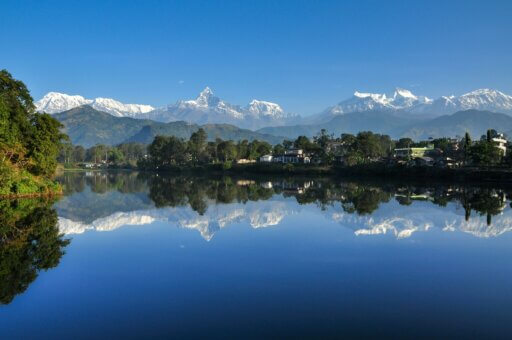
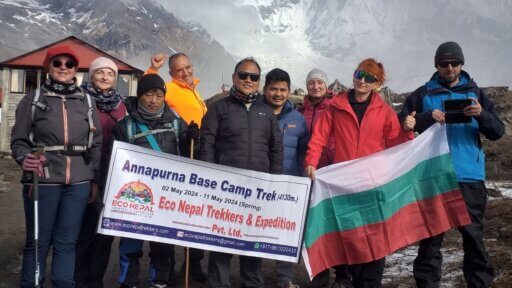
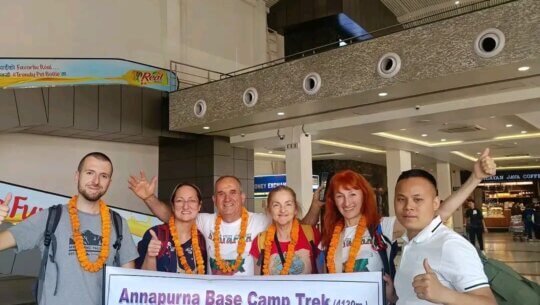
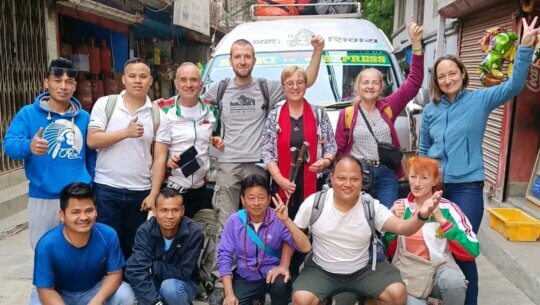
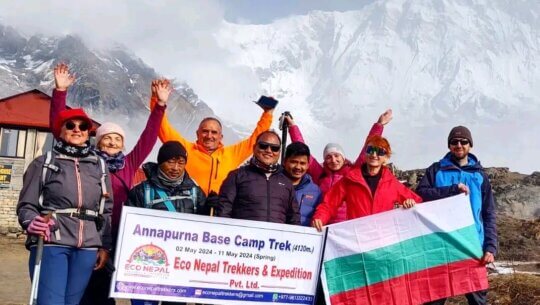
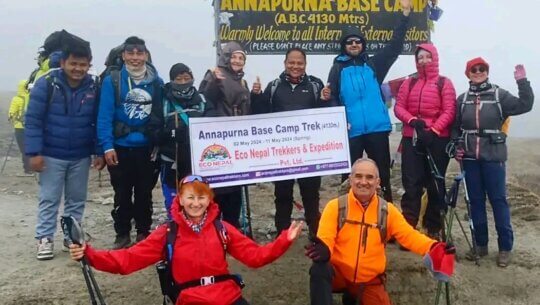
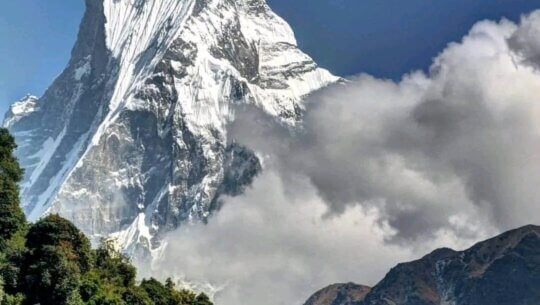
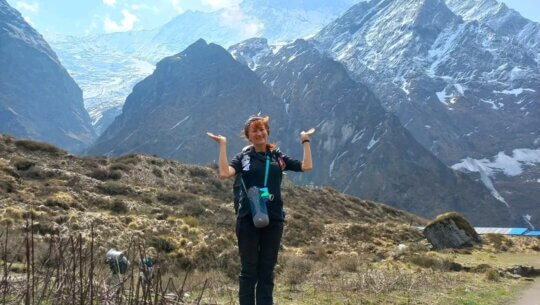
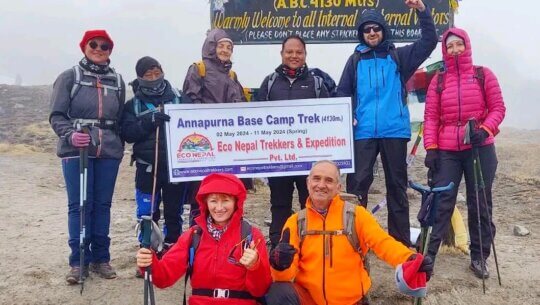
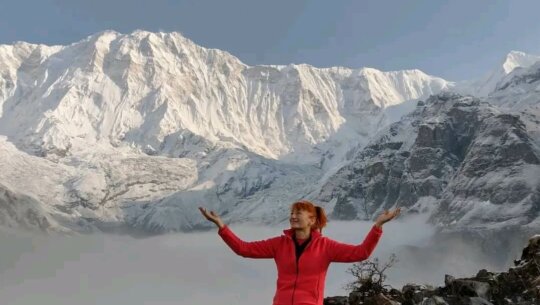
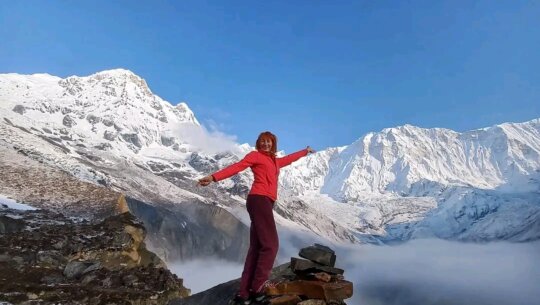
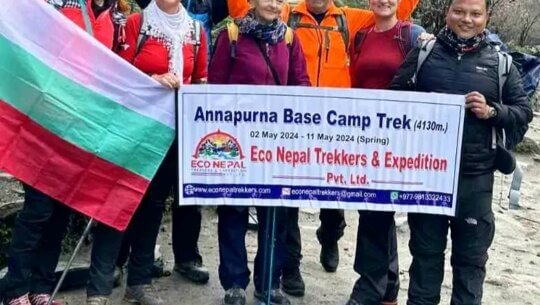

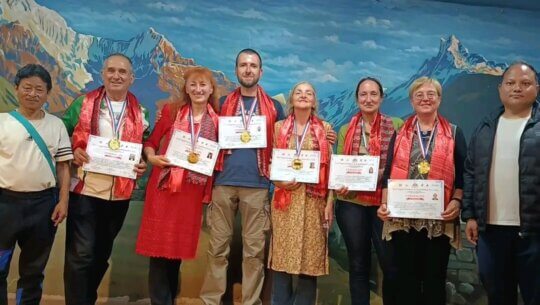
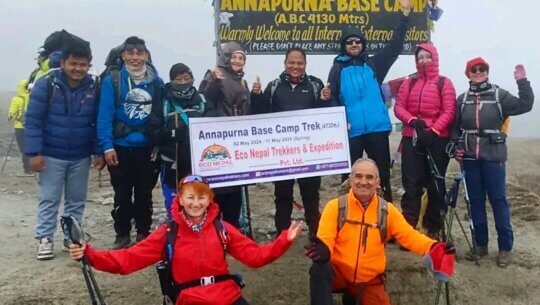
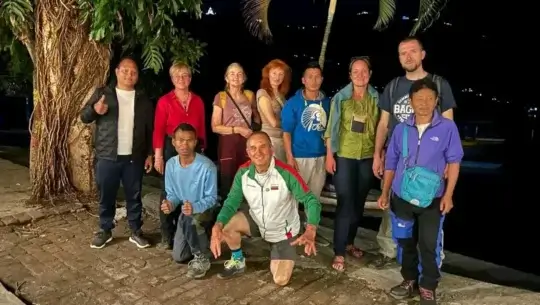



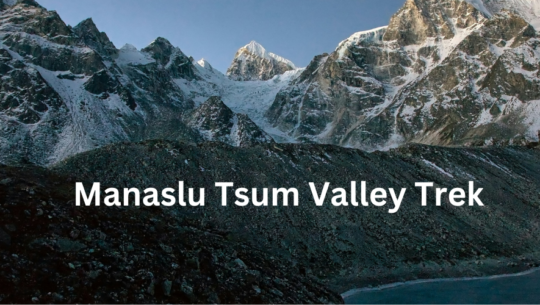
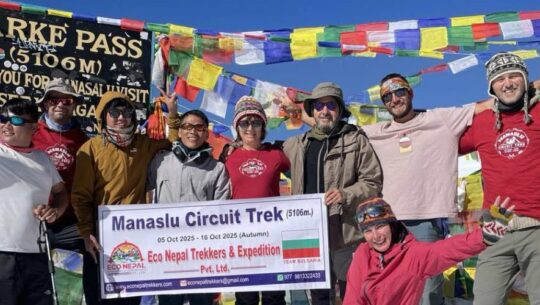
Linda Khor
Singapore, Singapore
100% Highly Recommended and Unforgetable ABC Trek
I recently had the privilege of embarking on the Annapurna Base Camp Trek with Eco Nepal Trekkers and Expedition, and I must say, it was an unforgettable journey thanks to their exceptional services. Led by our knowledgeable guide, Kiran Tamang, and supported by the informative tour operator, Pemba, every aspect of the trek was meticulously planned and executed, ensuring a seamless and enriching experience throughout.
From the moment we set foot on the trail, Kiran’s expertise became evident. His profound knowledge of the Annapurna region, its trails, and its culture added immense value to our trekking adventure. Kiran’s guidance not only ensured our safety but also enriched our journey with insightful information about the surrounding landscapes, flora, and fauna. His friendly demeanor and willingness to share his experiences made every step of the trek enjoyable and educational.
The team at Eco Nepal Trekkers and Expedition truly goes above and beyond to deliver an outstanding trekking experience. Their commitment to sustainable tourism practices and responsible trekking further enhanced the overall journey, allowing us to immerse ourselves in the beauty of the Annapurna region while minimizing our environmental impact.
In conclusion, I wholeheartedly recommend Eco Nepal Trekkers and Expedition to anyone seeking a memorable trekking experience in Nepal. With their knowledgeable guides, attentive staff, and dedication to excellence, they set the standard for trekking adventures in the Himalayas. My Annapurna Base Camp Trek with them will remain etched in my memory as a truly unforgettable experience, and I eagerly look forward to exploring more of Nepal’s wonders with them in the future.
Guided by: Kiran Tamang
Jorge G
Madrid, Spain
Annapurna Base Camp Trek Amazing Experince With Eco Nepal Trekkers
I had the incredible opportunity to travel with this company to the Annapurna Base Camp, and I couldn’t be more satisfied with the experience. From start to finish, their professionalism and dedication stood out. The customer service was exceptional—always attentive and caring throughout the entire trip. Pemba and his father went above and beyond to make me feel like part of their family. Whether it was helping me shop in Kathmandu, sharing meals together, or showing me the city’s most iconic landmarks, they were there every step of the way, ensuring I felt supported and welcome.
I am deeply grateful for their kindness, knowledge, and the unforgettable journey they provided. This is a serious and trustworthy company, and I recommend them 100% to anyone looking for an authentic and well-organized adventure in Nepal.
Sending a warm hug to my Nepalese family—thank you for everything
Guided by: Chhewang Tamang
kalina micheva
Sofia, Bulgeria
Embarking on the 12-day Annapurna Base Camp trek
Embarking on the 12-day Annapurna Base Camp trek with Eco Nepal Trekkers & Expedition was truly an unforgettable experience. From the moment we arrived until the final day, the team’s professionalism, care, and attention to detail made the entire journey seamless and enjoyable. The breathtaking landscapes of the Annapurna region—snow-capped peaks, lush forests, and charming villages—were made even more special by the peace of mind that came from being in such capable and dedicated hands. Every step of the way, we felt supported, safe, and valued.
This is more than just a trekking company; it’s a team that treats you like family and goes above and beyond to make your adventure truly exceptional. Highly recommended for anyone seeking a meaningful and well-organized Himalayan trekking experience.
Guided by: Manil Rana
Shang Yi-Shang
Taipei, Taiwan
Incredible 12-Day Annapurna Base Camp with Eco Nepal Trekkers!
I recently completed the 12-day Annapurna Base Camp (ABC) with Eco Nepal Trekkers and Expedition, and it was truly one of the most unforgettable experiences of my life. Everything was perfectly organized, professional, and filled with care from beginning to end. Our guide, Kiran, was outstanding—knowledgeable, friendly, and always attentive to our needs. He shared so much about the local culture and made sure we felt safe and supported throughout the journey. His positive energy made the trek even more special.
The trek itself was stunning, with diverse landscapes, welcoming villages, and the incredible reward of reaching base camp surrounded by the Annapurna peaks.
Eco Nepal Trekkers took care of every detail, from permits to accommodations, with great attention and passion. I highly recommend them—and if you get Kiran as your guide, you’re in for an unforgettable journey!
Guided by: Kiran Tamang